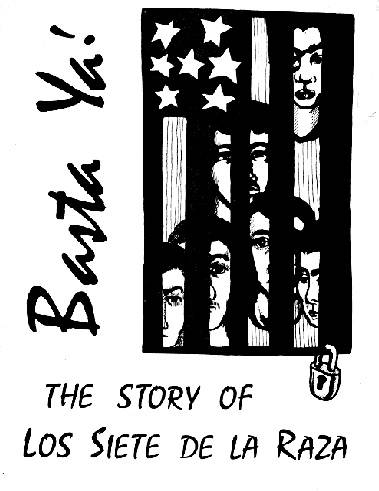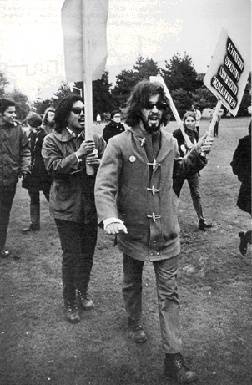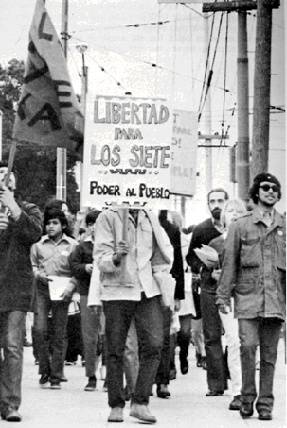LOS SIETE DE LA RAZA: Difference between revisions
No edit summary |
mNo edit summary |
||
| (8 intermediate revisions by 3 users not shown) | |||
| Line 1: | Line 1: | ||
'''<font face = Papyrus> <font color = maroon> <font size = 4>Primary Source</font></font> </font>''' | |||
''"The Story of Los Siete de la Raza" from'' Basta Ya!, ''1969'' | |||
[[Image:bastaya$los-siete-cover.jpg]] | |||
'''Los Siete cover of ''Basta Ya'' (1969)''' | |||
[[Image:Mission%24los-siete-2.jpg]] | [[Image:Mission%24los-siete-2.jpg]] | ||
'''Strike at San Francisco State: Nelson Rodriguez (far left), Ralph Ruiz (foreground), 1969.''' ''Photo: Greg Heins'' | '''Strike at San Francisco State: Nelson Rodriguez (far left), Ralph Ruiz (foreground), 1969.''' | ||
''Photo: Greg Heins'' | |||
[[Image:Mission%24los-siete-1.jpg]] | [[Image:Mission%24los-siete-1.jpg]] | ||
'''Protesters in the Mission, 1969.''' | '''Protesters in the Mission, 1969.''' | ||
''Photo: Los Siete de la Raza'' | |||
WHAT ACTUALLY HAPPENED ON MAY 1, 1969, the day that Joe Brodnik died and his partner Paul McGoran was wounded, will probably never come out. But long before any trial began, the newspapers, the other mass media, Mayor and the police, had already accused and convicted seven young men of murder. | WHAT ACTUALLY HAPPENED ON MAY 1, 1969, the day that Joe Brodnik died and his partner Paul McGoran was wounded, will probably never come out. But long before any trial began, the newspapers, the other mass media, Mayor and the police, had already accused and convicted seven young men of murder. | ||
| Line 41: | Line 49: | ||
Seven Latino brothers have been charged with murder. Four of them were not even on the street when the incident occurred. According to McGoran himself, two were upstairs in the house when the shooting took place. Nelson Rodriguez and Tony Martinez were not even in the city at the time. Nelson was in San Mateo, and Tony was in class at the College of San Mateo. | Seven Latino brothers have been charged with murder. Four of them were not even on the street when the incident occurred. According to McGoran himself, two were upstairs in the house when the shooting took place. Nelson Rodriguez and Tony Martinez were not even in the city at the time. Nelson was in San Mateo, and Tony was in class at the College of San Mateo. | ||
[[Los Siete |Prev. Document]] [[FSLN | <hr> | ||
[[Image:Tours-dissent.gif|link=The Indian Occupation of ALCATRAZ]] [[The Indian Occupation of ALCATRAZ| Continue Dissent Tour]] | |||
[[Los Siete |Prev. Document]] [[FSLN in the Mission Late 1970s | Next Document]] | |||
[[category:Mission]] [[category:Basta Ya! Community Newspaper]] [[category:1970s]] [[category:1960s | [[category:Mission]] [[category:Basta Ya! Community Newspaper]] [[category:1970s]] [[category:1960s]] [[category:Latino]] | ||
Latest revision as of 14:16, 2 September 2014
Primary Source
"The Story of Los Siete de la Raza" from Basta Ya!, 1969
Los Siete cover of Basta Ya (1969)
Strike at San Francisco State: Nelson Rodriguez (far left), Ralph Ruiz (foreground), 1969.
Photo: Greg Heins
Protesters in the Mission, 1969.
Photo: Los Siete de la Raza
WHAT ACTUALLY HAPPENED ON MAY 1, 1969, the day that Joe Brodnik died and his partner Paul McGoran was wounded, will probably never come out. But long before any trial began, the newspapers, the other mass media, Mayor and the police, had already accused and convicted seven young men of murder.
"Hoodlums" and "Latin hippie" types, the Chronicle called the seven. "A bunch of punks," the Mayor said. As far as most readers were concerned it seemed to be an open and shut case: A gang of young thieves attacked two brave and "idealistic" cops, killing one. The widow of the dead policeman has been campaigning for the death penalty for the seven "killers," and most of the jurors have undoubtedly been affected by this publicity. But a growing number of people deny that Los Siete de la Raza (the Seven of the Race) are murderers.
Many in San Francisco's largely Latino Mission district knew these young men, knew them as students at the College of San Mateo, as organizers for its outstanding "College Readiness Program," and as "brothers on the block" who had decided to go back to school to develop the skills to serve their people. Los Siete had personally convinced dozens of Latin street youths to go to college, but the newspapers had their own reasons for ignoring these facts, so they painted Los Siete as evil-doers and the police as all good.
DID THEY DO IT? A fair trial is supposed to answer this question. But the atmosphere of presumed guilt created by the newspapers condemns the seven already on the basis of circumstantial or irrelevant evidence.
The San Francisco Chronicle's coverage of Los Siete actually began one week before Joe Brodnik's death. A front page story on April 24, 1969, described "A Gang's Terror in the Mission" -- "A loose-knit gang of idlers and Mission District neighborhood hoodlums are slowly closing a fist of fear around the business life of a once bustling Mission District neighborhood. . ."
The story was a complete fiction. Five days later another story in the Chronicle ran saying that business was never better, and that there was no "reign of terror." Some of the merchants personally apologized to Nelson Rodriguez, one of the so-called hoodlums and now one of Los Siete.
But it didn't matter that the story was a lie. It had accomplished its purpose. There was now an excuse for Alioto to form the new squad of 150 cops "to deal with these punks." The police now had a blank check for terror in the community.
These extra cops, in the week before Brodnik's death, intensified the police occupation of the Mission district in order to force young people off the streets. Any time two or more young Latinos were spotted together, the police would shove them up against wall and see if they could find an excuse for arresting them. As the Chronicle explained it, "their job centers around stopping suspicious characters and making sure they are not involved in illegal activity."
In the eyes of a cop, who is suspicious? "I would stop any suspicious looking person," McGoran told a Grand Jury recently, "Latino, Black or Chinese."
For black and brown people, being stopped by the police is a terrifying situation, because there is no telling what a cop will do. In the last year, a half-dozen black or brown people have been injured by police gunfire. George Baskett was killed by "Officer" O'Brien during an argument after a minor traffic accident. O'Brien had been drinking. A Chinese woman was shot in the head when a sleepy, drunk cop who lived nearby shot at a howling cat. And recently, a black man, who (police say) had tried to pass a bad check, was shot in the back and killed by a cop. Needless to say, none of these cops was punished.
Black and brown people know that even a minor encounter with the police can result in death.
McGoran and Brodnik (and the two-foot rubber hose Brodnik carried with him) were notorious in the community for their harassment of brothers. They were among the most brutal cops, beating and arresting strikers at San Francisco State College and at Mission High. The night before Brodnik's death, Brodnik and McGoran broke into the home of a Latino active in the Mission and threatened him and his family.
WHAT HAPPENED ON MAY 1ST? Everyone agrees on a bare outline of facts. Brodnik and McGoran were dressed in plainclothes and they were driving an old, battered, unmarked car. They came upon a few young Latinos. One, police claim, was transferring a television set into a car from the home of Jose Bios, 18, one of their friends. The cops stopped and questioned them. Scuffling broke out. Shots were fired and seconds later Brodnik lay dead on the sidewalk, with a bullet from McGoran's gun in him. McGoran was injured. A week later, six of the seven were captured. The seventh, Gio Lopez, remains free.
Beyond these facts, the police story falls apart. Not a single witness even claims to have seen the fatal shot fired. No evidence links all seven with the scuffle that came before Brodnik's death. And at least one of the seven is proven innocent by McGoran's testimony!
Seven Latino brothers have been charged with murder. Four of them were not even on the street when the incident occurred. According to McGoran himself, two were upstairs in the house when the shooting took place. Nelson Rodriguez and Tony Martinez were not even in the city at the time. Nelson was in San Mateo, and Tony was in class at the College of San Mateo.



